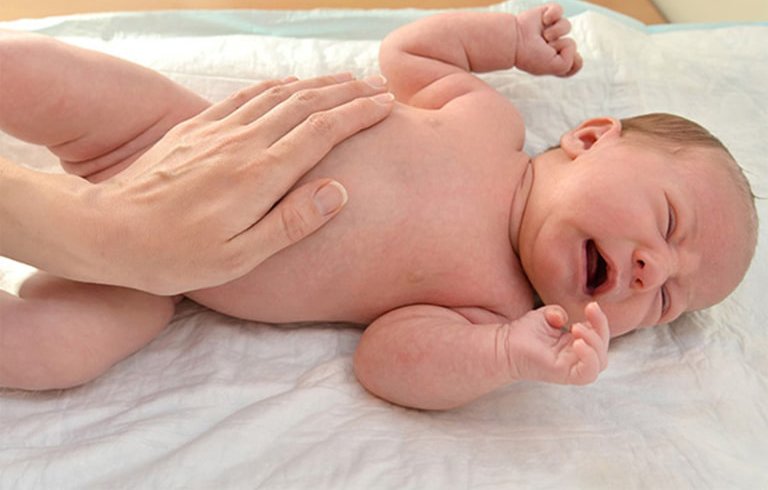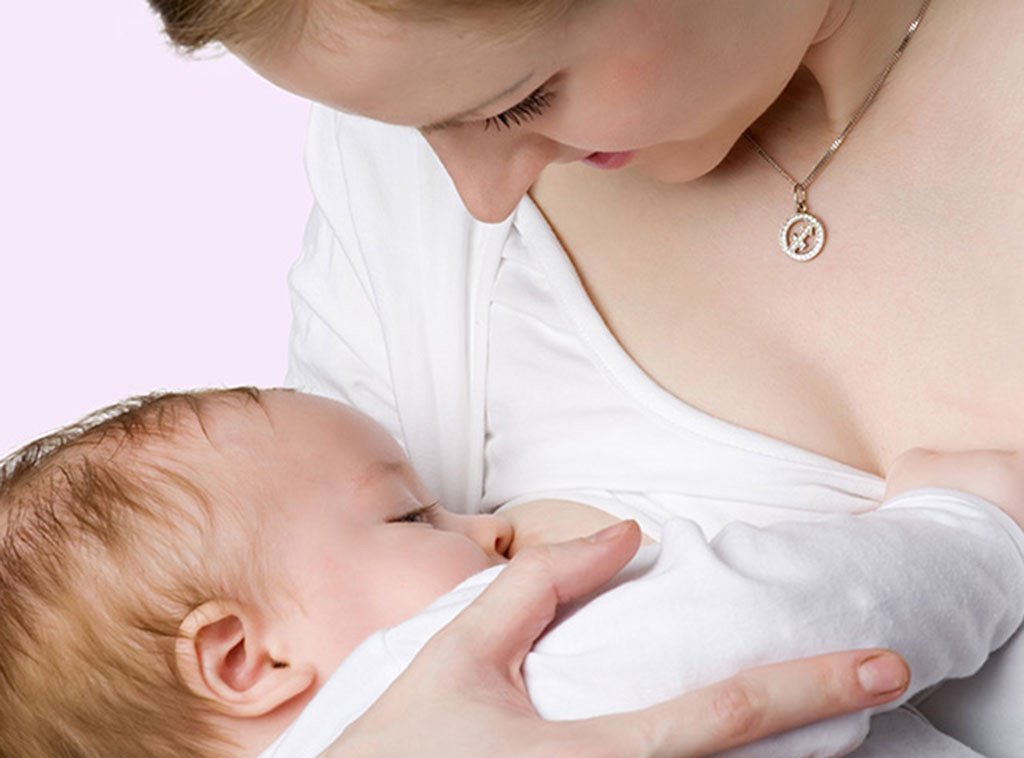Diagnosis and treatment of necrotizing enterocolitis in preterm neonates
The article was professionally consulted by Specialist Doctor II Cao Thi Thanh - Pediatrician - Department of Pediatrics - Neonatology - Vinmec Hai Phong International General Hospital.
Neonatal necrotizing enterocolitis is common in premature, low birth weight infants. The disease progresses rapidly, which can lead to complications such as intestinal perforation, intestinal obstruction, and peritonitis. If not detected and treated promptly, neonatal necrotizing enterocolitis can lead to death.
1. What is necrotizing enterocolitis?
Necrotizing enterocolitis is a condition in which the intestines become infected and may begin to become necrotic. This is an acute intestinal disease, common among children's digestive diseases, especially premature babies (accounting for 70-80% of children with low gestational age). Babies born at full term can also get this disease, but less often.
If the disease is not detected and treated promptly, the intestinal wall will necrosis, causing intestinal perforation, gastrointestinal effusion into the abdominal cavity, leading to intestinal obstruction, peritonitis. These complications can be fatal and require immediate surgery.
The cause of neonatal necrotizing enterocolitis is unknown. However, there are many factors involved in the disease including: Prematurity (premature babies' intestines are not as mature as full-term babies), infections, damage to blood vessels, reduced blood flow to the intestines, asphyxia at birth. , postpartum respiratory failure, congenital heart disease, metabolic abnormalities, abnormal fetal development, hypothermia, infant formula feeding,...
If the disease is not detected and treated promptly, the intestinal wall will necrosis, causing intestinal perforation, gastrointestinal effusion into the abdominal cavity, leading to intestinal obstruction, peritonitis. These complications can be fatal and require immediate surgery.
The cause of neonatal necrotizing enterocolitis is unknown. However, there are many factors involved in the disease including: Prematurity (premature babies' intestines are not as mature as full-term babies), infections, damage to blood vessels, reduced blood flow to the intestines, asphyxia at birth. , postpartum respiratory failure, congenital heart disease, metabolic abnormalities, abnormal fetal development, hypothermia, infant formula feeding,...
2. Diagnosis of necrotizing enterocolitis in preterm neonates
2.1 Diagnosis based on clinical symptoms Early stage: Lethargy, lethargy, unstable temperature, abdominal pain above or around the navel, slow digestion of gastric juice, fluid retention about 20%. The child has short episodes of apnea, the heart rate may be slow, and the blood sugar is low; The next stage: Children vomit yellow fluid, pale skin, severe abdominal pain, diarrhea, sometimes whole or microscopic blood in the stool. Accompanied by symptoms of abdominal distension, rectal examination is sometimes bloody. Late stage: The gastric juice is dark brown, with shock, severe abdominal pain, distended abdomen, erythematous wall, peritoneal tenderness, peritonitis.

Chẩn đoán viêm ruột hoại tử ở trẻ sơ sinh non tháng
2.2 Diagnostic tests for necrotizing enterocolitis in preterm neonates Peripheral blood tests: white blood cells increased, platelets decreased. Arterial blood gas test: Metabolic acidosis. Electrolyte : Sodium decreased, Potassium increased; Coagulation function test: There may be a clotting disorder; Stool culture, look for red blood cells in the stool; Peritoneal effusion: Blood or pus; Examine the culture for gram (-); Abdominal X-ray: The image of air in the intestinal wall is a characteristic sign that helps doctors diagnose the disease. Free intra-abdominal air indicates a complication of intestinal perforation. The bowel loop is immobile, dilated on multiple films showing necrosis of the intestinal loop. Absence of intestinal gas is a sign of peritonitis; Abdominal scan every 6-8 hours in the first 48 hours. Then, take abdominal scan every 8 - 12 hours until the disease is stable to detect surgical abdominal signs; Bacteria: Culture of blood, stool and peritoneal fluid (usually caused by E.coli, Proteus, Klebsiella, Staphylococcus,...).
3. Treatment of necrotizing enterocolitis in preterm infants
3.1 Medical treatment Medical measures should be taken as soon as there are signs that the patient has necrotizing enterocolitis, without waiting until the diagnosis is certain to avoid missing the opportunity to treat the disease early. Methods include:
Oral fasting: inserting a nasogastric tube to drain gastric juice. Resume oral feeding only when the clinical improvement is good (no bleeding, no abdominal distention) or at least 5 days after abdominal X-ray shows that the disease is under control (no longer intestinal gas. ). If an umbilical vein catheter is in place, the catheter should be removed. Combined with electrolyte replacement, anti-shock, treatment of DIC. When hemodynamically stable, switch to total parenteral nutrition for 1 - 2 weeks; Initial antibiotics: Use Ampicillin + Cefotaxime/Gentamicin + Metronidazol. If there is no response, the antibiotic should be changed according to the antibiogram. If antibiogram is not available, use pefloxacin in combination with metronidazole. The duration of antibiotic use for pediatric patients with necrotizing enterocolitis is 10-14 days; Close follow-up: Clinical signs of bowel obstruction, abdominal circumference, abdominal X-ray every 8-12 hours in unstable disease stage to promptly detect surgical complications and have timely treatment plans time, efficiency.
Oral fasting: inserting a nasogastric tube to drain gastric juice. Resume oral feeding only when the clinical improvement is good (no bleeding, no abdominal distention) or at least 5 days after abdominal X-ray shows that the disease is under control (no longer intestinal gas. ). If an umbilical vein catheter is in place, the catheter should be removed. Combined with electrolyte replacement, anti-shock, treatment of DIC. When hemodynamically stable, switch to total parenteral nutrition for 1 - 2 weeks; Initial antibiotics: Use Ampicillin + Cefotaxime/Gentamicin + Metronidazol. If there is no response, the antibiotic should be changed according to the antibiogram. If antibiogram is not available, use pefloxacin in combination with metronidazole. The duration of antibiotic use for pediatric patients with necrotizing enterocolitis is 10-14 days; Close follow-up: Clinical signs of bowel obstruction, abdominal circumference, abdominal X-ray every 8-12 hours in unstable disease stage to promptly detect surgical complications and have timely treatment plans time, efficiency.

Theo dõi dấu hiệu viêm ruột hoại tử ở trẻ để có phương án điều trị kịp thời
3.2 Surgical treatment Surgical intervention: Indicated in the case of children with intestinal perforation, peritonitis, necrotic loop of intestine, intestinal obstruction. Consider surgery when medical treatment after 48-72 hours but condition does not improve, thrombocytopenia, metabolic acidosis and coagulopathy continue. The doctor will remove the necrotic bowel and other infected parts. The intestines will be reattached or will be transferred to the abdominal wall through the colostomy. The treatment will continue until complete cure of the disease; Nutrition in preterm infants: Refeed the infant when clinically stable, the abdomen is soft without distention, no gastric juice stagnation and no blood in the stool. Children should be breastfed. In children who detect and treat necrotizing enterocolitis at an early stage, they can be fed earlier, after 72 hours. For children with necrotizing enterocolitis detected and treated at a later stage, it is necessary to fast by mouth for at least 10-14 days. Start breastfeeding with 10ml/kg of breast milk, then gradually increase to 10ml/kg per day. At the same time, it is necessary to closely monitor the excess fluid in the stomach, the condition of the abdomen and the occult blood in the stool of the pediatric patient. *Note: Be careful when giving children some drugs such as: xanthine group (theophylline, aminoside), vitamin E for prolonged use, indometacin, cytokines, cocaine,...
4. Measures to prevent necrotizing enterocolitis in premature infants
Pregnant women should have regular antenatal check-ups according to the doctor's appointment. It is necessary to detect pregnant women at high risk of comorbidities during pregnancy or underlying medical conditions in the mother for effective prevention; Having a specific strategy on treatment and care for pregnant women to help the fetus in the womb have good health and develop in accordance with each stage of pregnancy; Avoid premature birth. It is necessary to understand the cases of birth early compared to the due date to have a good treatment, to help the fetus develop well; Avoid other risks during and after birth such as: asphyxia, prolonged respiratory failure, polycythemia in premature infants; Care should be taken when feeding preterm infants by enteral feeding because feeding them in large quantities, rapidly increasing the quantity with unreasonable time is a risk of causing necrotizing enterocolitis. Children should eat slowly with each meal in small amounts. Good regulation of the time and amount of milk in the meal can prevent necrotizing enterocolitis. The amount of milk should be gradually increased to no more than 20ml/kg/day. At the same time, it is necessary to monitor and evaluate the child's milk tolerance status; Babies need to be breastfed right in the first hours after birth because breast milk contains many protective factors such as IgA, IgG, IgM,... that help reduce the risk of necrotizing enterocolitis in premature babies. Mothers should exclusively breastfeed their babies day and night. In order to have an abundant milk supply, pregnant women need to eat nutritious food, focus on protein, and get enough rest and sleep.

Trẻ bú sữa mẹ sớm giúp giảm nguy cơ viêm ruột hoại tử
Necrotizing enterocolitis in premature infants progresses rapidly, leaving severe consequences for the pediatric patient. Therefore, couples need to pay attention to the prevention of necrotizing enterocolitis for the baby, especially with premature babies. At the same time, when seeing that the baby has symptoms of necrotizing enterocolitis, it is necessary for the child to go to the doctor immediately for an accurate diagnosis and timely treatment.
Pediatrics department at Vinmec International General Hospital is the address for receiving and examining diseases that infants and young children are susceptible to: viral fever, bacterial fever, otitis media, pneumonia in children, .... With modern equipment, sterile space, minimizing the impact as well as the risk of disease spread. Along with that is the dedication from the doctors with professional experience with pediatric patients, making the examination no longer a concern of the parents.
Doctor Thanh has worked for 25 years in the treatment of neonatal pediatric diseases, of which 23 years worked at the neonatal department of Hai Phong Obstetrics and Gynecology Hospital (with experience in neonatal resuscitation in the operating room/room). giving birth + taking care of late premature babies (34 weeks - 37 weeks), 02 years working at Hai Phong Children's Hospital Requesting Clinic.Dr. Thanh is currently working in Pediatrics - Neonatology Department of International General Hospital Vinmec Hai Phong
Pediatrics department at Vinmec International General Hospital is the address for receiving and examining diseases that infants and young children are susceptible to: viral fever, bacterial fever, otitis media, pneumonia in children, .... With modern equipment, sterile space, minimizing the impact as well as the risk of disease spread. Along with that is the dedication from the doctors with professional experience with pediatric patients, making the examination no longer a concern of the parents.
Doctor Thanh has worked for 25 years in the treatment of neonatal pediatric diseases, of which 23 years worked at the neonatal department of Hai Phong Obstetrics and Gynecology Hospital (with experience in neonatal resuscitation in the operating room/room). giving birth + taking care of late premature babies (34 weeks - 37 weeks), 02 years working at Hai Phong Children's Hospital Requesting Clinic.Dr. Thanh is currently working in Pediatrics - Neonatology Department of International General Hospital Vinmec Hai Phong
Để đặt lịch khám tại viện, Quý khách vui lòng bấm số HOTLINE hoặc đặt lịch trực tiếp TẠI ĐÂY. Tải và đặt lịch khám tự động trên ứng dụng MyVinmec để quản lý, theo dõi lịch và đặt hẹn mọi lúc mọi nơi ngay trên ứng dụng.






